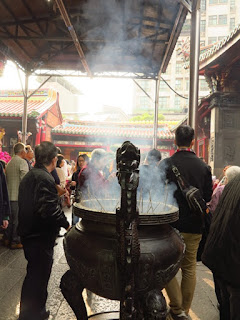Walk along any street in Taipei City, capital of
Taiwan, and you’ll see a foot massage parlor on most corners. More popular here
than Starbucks for a quick pick-me-up, a good rub-down of your feet and legs
does the job nicely. Foot massage parlors can accommodate dozens of patrons at
a time in comfortable massage chairs similar to what you might find in a nail
salon in the U.S.
 |
| Food massage is a full-body activity |
 |
| Larry preps for his massage. |
After soaking our feet in individual bowls, we lay
down and let each of our technicians go to work. Each lady massaged the lower
leg and calf, kneading, stroking, pressing, and pounding to get all the kinks
out. No buff and puff—this was an active massage. In fact, we had been taught
the words for “more” or “less” so we could make sure the pressure applied was
comfortable. Even though the massage lasted just half an hour, the soothing feelings
remained much longer.
Temples,
too |
| Longshan is a beautiful, but very busy, temple. |
Still feeling a bit euphoric, we left downtown and
headed to Longshan Temple. Built in 1738, it was a place of worship and a
gathering spot for Chinese settlers. Visiting on a Saturday, we found the
temple extremely crowded and the scent of incense almost overwhelming. But it
was interesting to see many people praying to various gods about almost anything
that might be going on in their lives, from the mundane to big picture issues
like jobs and marriage.
 |
| Worshipers light incense to offer the gods when making supplications. |
An
uneasy coalition
While in Taipei, we also visited the Chiang Kai-shek
Memorial Hall, a memorial to the man who unified China in 1928. After a civil
war between communist Mao Te Sung and capitalist Chiang Kai-shek, Taiwan was
defeated in 1948 and became People’s Republic of China.  |
| Singing is a form of worship for many Taiwanese Buddhists, especially the older generations. |
Today Republic of China is the country’s official
name rather than the more popular and locally preferred Taiwan. Tensions run
high regarding the status of Taiwan because it’s considered a rogue entity by mainland
China.
Modernization
Visitors looking for an upscale and modern shopping
experience can find that at Taipei 101, the tallest building in Taiwan. So named
because 10 + 1 means “better than perfect,” the building is designed to look
like bamboo, with outcroppings every eight stories (8 is a lucky number in Asia).
When built in 2015 the architecture was innovative and the building boasted the
world’s fastest elevator.
 |
| Young people flock to modern shopping venues. |








No comments:
Post a Comment